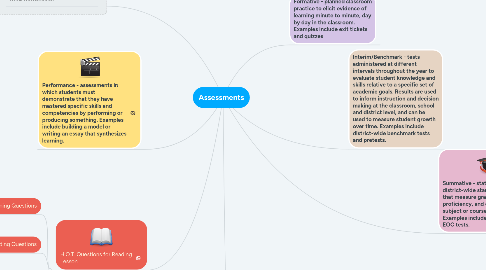
1. Performance - assessments in which students must demonstrate that they have mastered specific skills and competencies by performing or producing something. Examples include building a model or writing an essay that synthesizes learning.
2. Diagnostic - a form of pre-assessment that allows a teacher to determine students' individual strengths, weaknesses, knowledge, and skills prior to instruction. It is primarily used to diagnose student difficulties and to guide lesson and curriculum planning. Examples include pretests and KWL worksheets.
3. H.O.T. Questions for Reading Lesson
3.1. Opening Questions
3.1.1. What can you predict about this book from looking at the cover?
3.1.2. Do you think this story will be real or imaginary? What makes you think that?
3.2. Guiding Questions
3.2.1. Why do you think [character name] reacted to the main problem that way?
3.2.2. How do you think [character name] is going to solve the main problem?
3.3. Closing Questions
3.3.1. What was the main lesson in this story? Why do you think that?
3.3.2. How would the story change is [character name] had done something differently?
4. Formative - planned classroom practice to elicit evidence of learning minute to minute, day by day in the classroom. Examples include exit tickets and quizzes
5. Summative - state or district-wide standardized tests that measure grade-level proficiency, and end-of-year subject or course exams. Examples include STAAR and EOC tests.
6. Interim/Benchmark - tests administered at different intervals throughout the year to evaluate student knowledge and skills relative to a specific set of academic goals. Results are used to inform instruction and decision making at the classroom, school and district level, and can be used to measure student growth over time. Examples include district-wide benchmark tests and pretests.
7. Assessment Data
7.1. Student Diagnostic Report for Reading used to collect data on 3 third grade students. This data can be used to develop strategies to improve instruction.
7.1.1. AP - SS 85. Reads at 1.3 grade equivalent. Most significant challenges fall under comprehension skills.
7.1.2. CH - SS 247. Reads at 2.3 grade equivalent. Most significant challenges fall under comprehension skills.
7.1.3. QF - SS 143. Reads at 1.7 grade equivalent. Most significant challenges fall under comprehension skills
7.1.4. Strategies for improving reading comprehension skills are appropriate for all 3 students.
7.1.4.1. Strategy 1: Use graphic organizers or story maps to examine and discuss key story elements and major components.
7.1.4.2. Strategy 2: Teach students to "show proof" in reading selection for chosen answers. For example, write down the paragraph number for the answer chosen, and underline answer choice in selection.

